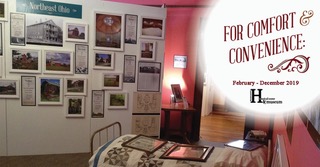Project Showcase: “For Comfort and Convenience”: Poverty and Material Culture
09 May 2019 – Holly A. Hartlerode

Image credit: Carmen Cano, Bowling Green Convention and Visitors Bureau
In a February blog post for History@Work, Kristin O’ Brassill-Kulfan asked public historians to think about the presentation of poverty in museum settings. That same month, the Wood County Historical Center (WCHC) in Bowling Green, Ohio opened a new exhibit titled For Comfort and Convenience: Public Charity in Ohio By Way of the Poor Farm. The exhibit, which I curated, provides an opportunity to explore some of the questions O’Brassill-Kulfan raised, especially regarding the material culture of poverty.
As O’Brassill-Kulfan suggests, poverty rarely leaves behind interpretive objects, so museums must approach this subject creatively. The WCHC operates out of the former Wood County Infirmary (also known as the “poor farm” or “county home”). Opened in 1869, this public charity building housed adults and children who were indigent, elderly, or physically disabled until the latter half of the twentieth century.
The WCHC holds nearly 100 years of institutional documentation about the people who lived in the Wood County Infirmary from 1869 through 1971. Much of this material appears in the exhibit. Visitors can see “Applications for Relief,” death certificates, and obituaries of former inmates. In this way, the exhibit seeks to humanize individuals who had been stereotyped and dehumanized in institutional contexts.
The Ohio State Board of Charities (OSBC) indirectly assisted county infirmaries by providing advice on what it called the “wise and economical dispensation” of public charity for the “comfort” of the inmate and the “convenience” of site administrators. In planning our exhibit, I designed the layout to mimic OSBC’s recommended spatial organization—especially the explicit separation of sexes—when representing dining rooms, sitting rooms, and bedrooms. Visitors witness the functionality of the kitchen, the rules for church services, and directives for inmates’ burial in the pauper cemetery.
Our attention to the material conditions of life at Wood County Infirmary illustrates how the institution controlled inmates even as it cared for them. This exhibit also incorporates archeological findings and architectural remnants unearthed from the many remodeling projects since the infirmary became a museum. Material culture items, like those found on site, support the notion that poverty was not always linked to a lack of financial means or that institutional living was cold or uncaring.
In addition to displaying the documents and objects in the WCHC’s collection, the museum collaborated with local photographer Jeffrey Hall, who traveled more than 5,000 miles to all 88 counties in Ohio to photograph the current condition of each former poor farm site. These photographs connect past and present and bring the history of the poor farm to the forefront as a catalyst for conversation about the situations and policies that led people to be housed in these places.
~ Holly A. Hartlerode is the curator at the Wood County Historical Center in Bowling Green, Ohio.




Holly,
I’m so glad to hear about this exhibit — and wish I were closet to Ohio to come visit! Thanks for this fascinating project showcase. I’d love to chat more, if you want to send me an email (I can’t find yours online!): kristin.obrassillkulfan at rutgers dot edu.
Cheers–
Kristin